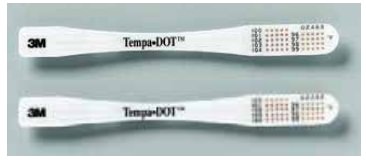Chapter: 11th Nursing : Chapter 5 : Nursing - Health Assessment and Physical Examination
Types of Thermometers
Types of Thermometers
1)
Mercury thermometers (Clinical thermometer)
2)
Electronic thermometer
3)
Temporal artery thermometer
4)
Disposable thermometer
1. Mercury thermometers (Clinical thermometer):
Clinical thermometers are meant for clinical purposes. It is
developed for measuring the human body temperature. It is a long narrow glass
tube with a bulb containing mercury at the end.
The normal human body temperature is 37ºC. It can
fluctuate between the ranges 35ºC. The level of mercury tells our body
temperature in ºC. Since mercury is toxic element has been eliminated from
health care facilities because of the environmental hazards of mercury. When
you find a mercury – in – glass thermometer in the home

Teach the patient about safer temperature devices and
encourage the disposal of mercury products at appropriate neighbourhood
hazardous disposal locations.
2. Electronic thermometer:
The electronic thermometer consists of a rechargable battery – powered
display unit, a thin wire cord and a temperature – processing probe covered by
a disposable probe cover. Separate unbreakable probes are available
For oral and rectal use. You can also use the oral probe
for auxiliary temperature measurement. Electronic thermometers provide two
modes of operation; a 4-second predictive temperature and a 3-minute standard
temperature. A sound signals, and a … Readings appears on the display unit when
the Peak temperature readings has been measured.

3. Temporal artery thermometer:
Measures the temperature of the
superficial temporal artery. A handheld scanner with an infrared sensor tip
defects the temperature of Cetaceous blood flow by sweeping the sensor across
the forehead and just behind the ear. After scanning is complete, a reading
appears on the display unit. Temporal artery temperature is reliable
non-invasive measure of core temperature.

4. Disposable thermometer:
Single use (or) reusable chemical dot thermometers are thin strips of
plastic with dots on the surface that have been impregnated with temperature –
sensitive chemicals. The strips are sticker on the armpit and prevent slippage.
The dots change colour at different temperatures (within
60 seconds) as the chemicals in them respond to body heat. In the Celsius
version there are 50 dots, each representing a temperature increment of 0.1ºC,
over a range of 35.5 – 40.4ºC.

The Fahrenheit version has 45 dots with increments of
0.2ºF and range of 96-104.8ºF. Disposable thermometers are usually for oral
temperatures. You also use them at auxiliary with a placement time of minutes.
Chemical dot thermometers are useful for screening temperatures, especially in
infants and young children and patients who are incubated.
Purpose of Taking Temperature
1)
To aid in diagnosis or the patient’s condition
2) To find out the progress of the
patient.
Related Topics